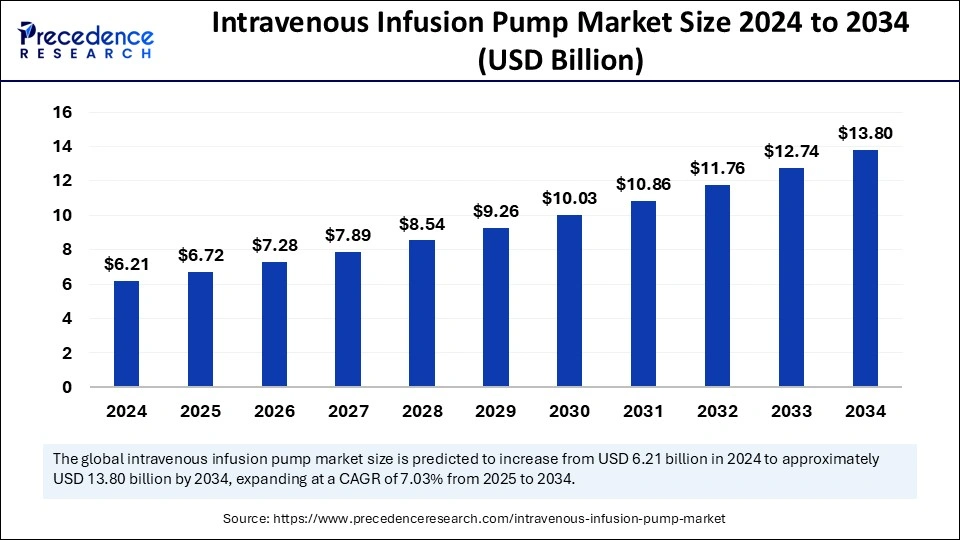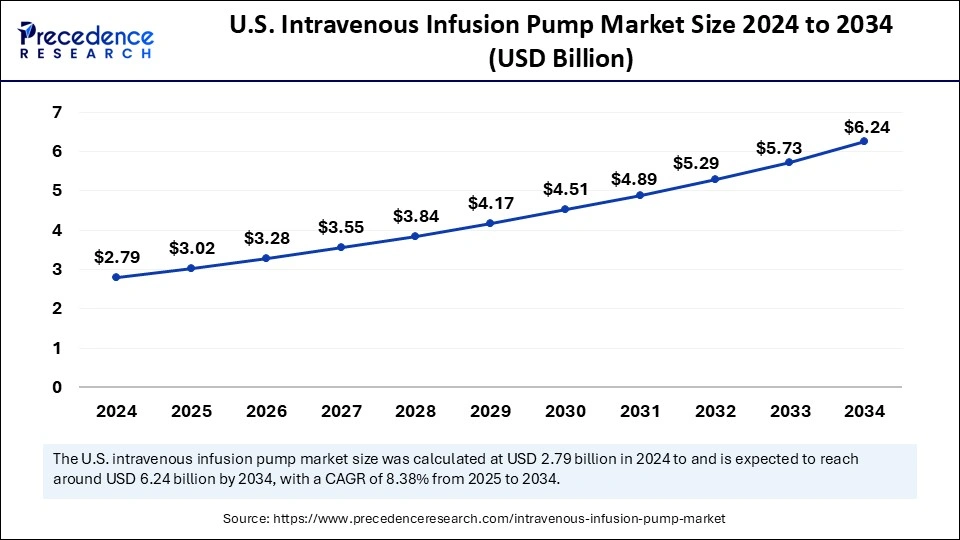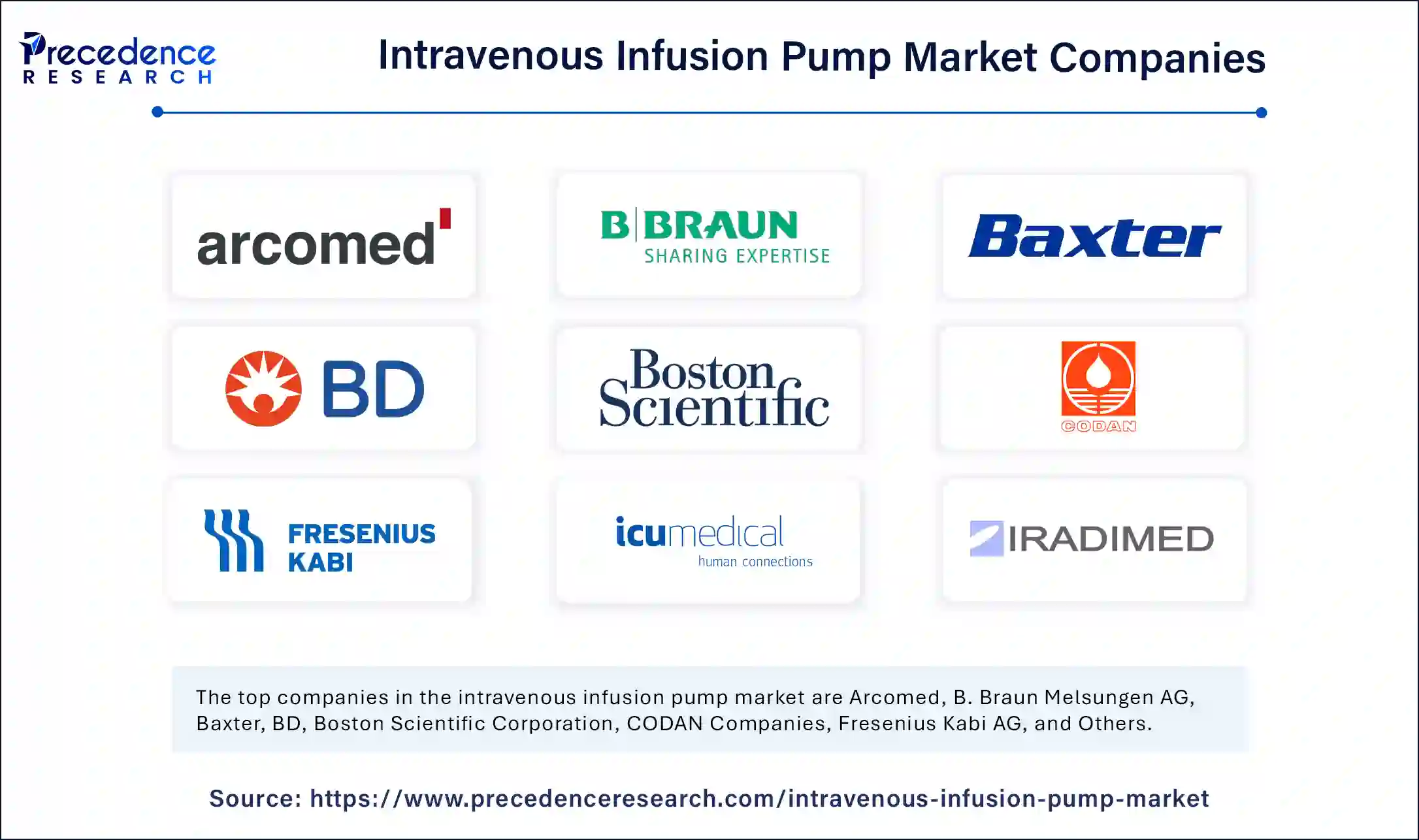July 2024
The global intravenous infusion pump market size is calculated at USD 6.72 billion in 2025 and is forecasted to reach around USD 13.80 billion by 2034, accelerating at a CAGR of 7.03% from 2025 to 2034. The North America market size surpassed USD 3.11 billion in 2024 and is expanding at a CAGR of 8.30% during the forecast period. The market sizing and forecasts are revenue-based (USD Million/Billion), with 2024 as the base year.
The global intravenous infusion pump market size accounted for USD 6.21 billion in 2024 and is predicted to increase from USD 6.72 billion in 2025 to approximately USD 13.80 billion by 2034, expanding at a CAGR of 7.03% from 2025 to 2034. The growth of the market is driven by the increase of chronic diseases, growing healthcare spending, and an aging population. The increase in surgical procedures and the movement to home healthcare is driving demand for more advanced and portable infusion pumps.

The intravenous infusion pump market is being transformed by artificial intelligence, improving the precision, safety, and efficiency of delivering drugs. An infusion pump that uses AI can evaluate data from a patient in real time to recommend a dosage, reducing the chance of errors in medication delivery. For example, smart infusion pumps apply machine learning algorithms that spot abnormalities in infusion rates as a way to prevent adverse events like overdosing or air embolism.
In addition to patient safety, AI infusion pumps improve connectivity and offer automated monitoring. Finally, AI devices improve predictive maintenance and diagnose potential device failure before it happens, minimizing disruption to patient therapy.
The U.S. intravenous infusion pump market size was exhibited at USD 2.79 billion in 2024 and is projected to be worth around USD 6.24 billion by 2034, growing at a CAGR of 8.38% from 2025 to 2034.

North America Dominates the Intravenous Infusion Pump Market with Technological Advancements
North America held the dominating share of the intravenous infusion pump market in 2024 and is observed to sustain itself as a leader in the upcoming period due to rising awareness of fitness and the increased uptake of connected devices. Smart water bottles that incorporate Internet of Things and AI features-such as tracking hydration levels and syncing with mobile apps to optimize a user's water intake-have gained traction due to the penetration of technology into health and wellness products. Companies like HidrateSpark and Thermos lead the charge in offering these products. The growing attention toward the personalization of health data means more growth for North America as a region in the global industry.
The largest share of the North American market is held by the United States, driven by factors such as the aging population and increased hospitalization rates. With more than 30 million individuals suffering from diabetes and a larger number of patients requiring long-term care, the demand for safe and effective infusion therapy continues to grow. The demand for IV infusion pumps, especially in the home healthcare industry and long-term, is expected to follow suit with the country’s transition to an older society.

Asia Pacific: The Fastest-Growing Region for Intravenous Infusion Pump Market
The intravenous infusion pump market is growing fastest in Asia Pacific because of significant healthcare infrastructure development, increased investment in medical technology, and a heightened prevalence of chronic diseases. Many governments in the region are supporting efforts to increase accessibility and affordability for patients, which has led to the widespread utilization of infusion therapy solutions in hospitals and outpatient settings. The Singapore Economic Development Board (EDB) estimated that the region's medical technology market will reach USD 225 billion by 2030, demonstrating the rapidly evolving healthcare innovation in the region.
The fastest and largest growing market in Asia Pacific is China, which continues to rely on increasing healthcare costs and developing domestically manufactured solutions for drug delivery. The infusion therapy market has been evolving in China as domestic infusion pump developers like Mindray Medical and Sino Medical continue to enhance their solutions as they increasingly focus on growing their product offerings in infusion treatment. China alone has over 4 million new cancer diagnoses per year, which drives the demand for chemotherapy infusion pumps. This has subsequently led to increased demand for advanced infusion pump systems in urban and semi-urban populations.
Japan also plays a crucial role in the Asia Pacific market, thanks to its highly developed healthcare system and effective regulation. Japan has nearly the highest healthcare expenditure in the region at nearly 10% of its GDP, providing an environment for sustained investment in medical technology and digital health. Japan's healthcare system prioritizes accuracy and safety, driving the adoption of smart infusion pumps with dose error reductions systems (DERS) and wireless connectivity. Major Japanese medical device manufacturers like Terumo Corporation and Nipro are innovating infusion pump technologies to improve patient safety and effectiveness.
Digital Advancements and Aging Populations Propel Europe's Intravenous Infusion Pump Market Growth
The intravenous infusion pump market in Europe is gaining traction as increasing healthcare expenditure, the rise of chronic diseases, and improvements in treatments drive market growth. The European Union is focused on patient safety, and hospitals are becoming more digital, both of which are increasing the uptake of smart infusion devices. The development of home care services, specifically in aging populations, is driving demand for portable and wearable infusion pumps.
Germany is at the forefront of the market in Europe, supported by a robust medical technology sector and companies like B. Braun Melsungen AG and Fresenius Kabi. Demographic trends indicate that a growing portion of Germany's population, 21% age 65 or older, is a likely driver for increasing demand for infusion pumps for geriatric, oncology, and palliative use. The government of Germany is promoting the use of smart infusion systems with real-time monitoring capabilities to improve care models, such as through the powerful Hospital Future Act initiative.
The market for intravenous infusion pumps in the UK is witnessing continuous expansion owing to the rising occurrence of chronic ailments including diabetes and cancer, in which the growing cases of diabetes have also led to the increasing demand of infusion pumps for insulin. There has been much technological advancement recently emphasizing smart infusion pumps equipped with automation.
Such technologies further enhance patient safety and precision associated with treatment. The internal aging population has had a negative long-term health outcome, which has compounded the need for long infusion treatments and is part of a generalized enlargement in the market throughout the infusion pump industry in Europe overall.
An intravenous infusion pump is defined as a medical device that delivers fluids, medication, or nutrients in a controlled manner into the bloodstream of the patient. These pumps are used across a wide variety of healthcare facilities, including hospitals, outpatient clinics, and at home, as a means of controlling precise rates of drug delivery. The market consists of different varieties, including volumetric pumps, syringe pumps, patient-controlled analgesia (PCA) pumps, and ambulatory pumps.
The intravenous infusion pump market is driven by the need for accurate drug delivery in critical care, pain management, chemotherapy, and diabetes treatment. Other factors driving the market include advancements in technology, an increase in surgical procedures, and rising demand for home healthcare solutions. Additionally, the advent of smart pumps with wireless connectivity for dose-error reduction will offer safety and efficiency to practitioners and patients alike. Extreme amounts of research and development are focusing on automation, portability, and usability.
| Report Coverage | Details |
| Market Size by 2034 | USD 13.80 Billion |
| Market Size in 2025 | USD 6.72 Billion |
| Market Size in 2024 | USD 6.21 Billion |
| Market Growth Rate from 2025 to 2034 | CAGR of 7.03% |
| Dominating Region | North America |
| Fastest Growing Region | Asia Pacific |
| Base Year | 2024 |
| Forecast Period | 2025 to 2034 |
| Segments Covered | Product Type, Disease Indication and Regions. |
| Regions Covered | North America, Europe, Asia-Pacific, Latin America, and Middle East & Africa |
Rising Surgeries
The growing incidence of surgical procedures worldwide creates a strong need for intravenous infusion pumps, which enable accurate medication and fluid administration during surgeries and recovery.
Also, advancements in surgery, such as robotic-assisted surgery, are also driving the growing need for precise and effective infusion devices. For example, Intuitive Surgical reported an 18% increase in global da Vinci procedures in the last quarter of 2024, demonstrating a shift toward minimally invasive procedures. As the number of surgical cases only increases, we expect sustained growth in IV infusion pumps as more surgical procedures occur in modern healthcare.
Infection risks and regulatory challenges
The threat of infections and complications associated with IV therapy is a fundamental limiting factor of the intravenous infusion market. Catheter-related bloodstream infections (CRBSIs) and sepsis are serious problems often stemming from poor catheter insertion and maintenance. The FDA, CDC, and other regulatory organizations have tightened safety guidelines for managing CRBSIs, mandating that hospitals formalize standard operating procedures regarding infection control, which can increase operating costs.
Rising chronic diseases
Chronic diseases continue to be a major health burden to the global population, including heart disease, stroke, diabetes, and cancer.
In fact, according to the World Health Organization, 73.9% of deaths globally are due to non-communicable diseases (NCDs). Additionally, about 1.8 billion adults are at increased risk of non-communicable diseases because they do not engage in sufficient physical activity. According to the NIH, there are about 422 million people with diabetes, and the prevalence of diabetes is continuing to increase.
Chronic diseases are contributing to the expanded use of intravenous infusion pumps, as many patients will require prolonged IV therapy for these conditions, including chemotherapy, insulin delivery, and parenteral nutrition. More and more patients require some sort of advanced intravenous infusion pump, in particular smart infusion systems that promote safety and efficiency during both hospital stays and home-health options. The ageing population will increase the likelihood of patients with chronic diseases, and therefore, the trend toward hospital or home-based treatment. The use of automated, connected, and precise infusion devices will ultimately see more prevalence in both acute and chronic care.
The volumetric infusion pump segment held the largest intravenous infusion pump market share in 2024, as they are frequently used to deliver fluids precisely, making them vital for accurately administering medications, nutrition, and blood products in an established amount. Volumetric infusion pumps maintain a dominant share in the market; their versatility administers medication for chronic diseases such as cancer, cardiovascular diseases, or neurological diseases. Innovations in technology, such as smart pumps with DERS, have solidified their leadership in the market. A rising global burden of chronic diseases accompanied by an accurate need for continuous infusion therapy and accurate volume administration sustains volumetric infusion pumps on the leading edge of the market.
The ambulatory infusion pump segment is anticipated to grow at a remarkable CAGR between 2025 and 2034, largely due to efforts to deliver care in the home and outpatient settings. These portable infusion pumps empower patients to receive long-term infusion therapies such as chemotherapy, analgesia, or antibiotics in a non-hospital setting. In addition, technology has improved infusion systems with wireless connectivity and wearable infusion delivery devices, allowing for improved mobility and adherence rates for patients. The growing incidence of chronic disease and the need to avoid hospital readmissions are also influencing the growth of ambulatory infusion pumps, and it is the fastest-growing segment.
The pediatrics/neonatology segment captured the biggest intravenous infusion pump market share in 2024, as there is a need for accurate fluid and medication delivery in this patient population. In the neonatal intensive care unit (NICU), there is a critical requirement for infusion pumps for preterm birth, congenital anomalies, and serious morbidity. Trending towards more sophisticated “smart pumps” for controlled dosing and safety alarms further drive a demand for infusion pumps in pediatrics or neonatology. There is an increasing trend towards better care in the neonatal population, which further drives infusion pumps.
The chemotherapy segment is growing the fastest, driven by the increasing incidence of blood-related conditions like leukemia, anemia, and hemophilia. The greater use of chemotherapy, biologics, and gene therapies has increased the demand for exact drug infusion systems. The emergence of targeted therapies and personalized medicine helps expand the demand as well. Research into chemotherapy will continue to build the need for programmable, controlled infusion pumps, which in turn will further promote rapid growth in the market value of this segment.
The hospitals held the dominant intravenous infusion pump market share in 2024. Intravenous administration is used to manage various medical conditions, including the delivery of chemotherapy and ensuring hydration and electrolyte balance in critically ill patients. It is also a crucial part of pre and post-surgery care. Hospital settings involve trained professionals and aseptic practices to perform IV procedures. They are also equipped with adequate measures in case of manual or equipment failures.
The homecare settings will expand at a significant CAGR between 2025 and 2034. A significantly growing aging population has resulted in increasing demand for home care services. In several regions, the governments are assiugning subsidies and budgets to meet this demand. In Europe alone, public health budgeting, spending increased from €15.3 billion in 2018 to a projected €22.8 billion in 2024, propelling the space forward. As healthcare shifts focus to home-based care for chronic diseases, elderly care, and even palliative care, there is a greater need for simpler to use and more portable infusion pumps, which will decrease admissions to hospitals, thereby driving down healthcare costs.

By Product Type
By Disease Indication
By Geography
For inquiries regarding discounts, bulk purchases, or customization requests, please contact us at sales@precedenceresearch.com
No cookie-cutter, only authentic analysis – take the 1st step to become a Precedence Research client
July 2024
July 2024
November 2024
December 2024